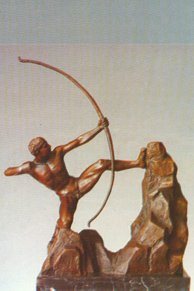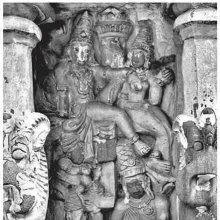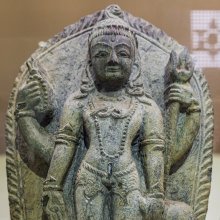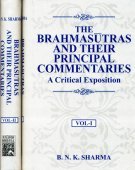Pashupata, Pāśupata, Pāśupatā, Pāśupaṭa: 23 definitions
Introduction:
Pashupata means something in Hinduism, Sanskrit, the history of ancient India, Marathi. If you want to know the exact meaning, history, etymology or English translation of this term then check out the descriptions on this page. Add your comment or reference to a book if you want to contribute to this summary article.
The Sanskrit terms Pāśupata and Pāśupatā and Pāśupaṭa can be transliterated into English as Pasupata or Pashupata, using the IAST transliteration scheme (?).
Images (photo gallery)
In Hinduism
Purana and Itihasa (epic history)
Source: archive.org: Puranic Encyclopedia1) Pāśupata (पाशुपत).—An aged brahmin. (See under Virūpākṣa).
2) Pāśupata (पाशुपत).—The missile of Śiva. Arjuna during his exile in the forests performed penance to propitiate Śiva and got this missile from him.
2) Śiva has a bow named Pināka. Pāśupata is the arrow that is used on that bow. Pināka is a serpent with the colours of a rainbow. It has seven heads and has fierce canine teeth. Poison flows from them always. The string of the bow is wound round the neck of Śiva. The arrow, bright like the sun and equal to the fire of death, is the Pāśupata. It will burn all that it touches. Neither Nārāyaṇāstra, Brahmāstra, Āgneyāstra nor Vāruṇāstra can stand against this. In times of old Śiva burnt the Tripuras (three cities of the notorious three demons) by this arrow. Even Brahmā and Viṣṇu could be killed by Pāśupata. (Chapter 14, Anuśāsana Parva). Devotees worship Pāśupata as a deity. If the Pāśupata mantra is recited once it will remove all obstacles from the way and if recited a hundred times it will end all your calamities and bring success in any war for you.
3) Pāśupata (पाशुपत).—The bhūtagaṇas (Spirits and devils attending on him) of Śiva as a class are called Pāśupatas. (Chapter 67, Vāmana Purāṇa).
Source: archive.org: Shiva Purana - English TranslationPāśupata (पाशुपत) refers to the “rite for the release of an individual soul (from the bondage of rebirth)”, according to the Śivapurāṇa 2.5.9 (“Śiva’s campaign”).—Accordingly, as Śiva said to the Gods: “O excellent gods, you will not fall even in your animal-hood. Let it be heard, and let the process of release from animal-hood be practised. He who performs the divine rite of Pāśupata will be released from animal-hood. I promise this to you. Be attentive. O excellent gods, there is no doubt about it that those who perform my Pāśupata rite will become liberated. He who renders service perpetually or for twelve years, becomes relieved of animal-hood. Hence O excellent gods, perform this divine rite. You will be released from animal-hood. There is no doubt about this”.
Source: Cologne Digital Sanskrit Dictionaries: The Purana Index1a) Pāśupata (पाशुपत).—The astra of Śiva.*
- * Brahmāṇḍa-purāṇa III. 31. 39; 32. 57; 34. 34; 40. 65. IV. 29. 140.
1b) A tīrtha on the Pārvatīkā, sacred to Pitṛs.*
- * Matsya-purāṇa 22. 56.
2) Pāśupatā (पाशुपता).—Followers of the Pāśupata yogam.*
- * Brahmāṇḍa-purāṇa III. 32. 5.
1) Pāśupata (पाशुपत) refers to “Śiva-worshippers”.—The system of Yoga followed by these Śiva-worshippers is called Pāśupatayoga, their vrata is called Pāśupatavrata and the knowledge of Śiva is called Pāśupatajñāna. The principal scriptures of these Pāśupatas are the Atharvaśiras Upaniṣad and the Śatarudrīya section of the Yajurveda. The Purāṇas describe the entire beings in the Universe as the flock (paśu) and the Śiva is the lord of the flock (paśupati) and Paśupati frees those beings from bondage (pāsa) who have extreme love and devotion to Śiva.
2) Pāśupata (पाशुपत) or Pāśupatavrata refers to type of Vrata (“religious observances”), according to the 10th century Saurapurāṇa: one of the various Upapurāṇas depicting Śaivism.—Accordingly, the Pāśupata-vrata is the most important mode of worship for [the Pāśupatas]. The Saurapurāṇa (45.64ff) describes the procedure for the observation of this vrata.
Accordingly,
“The person who practices this Pāśupata-vrata should be self-controlled. Having fasted from the previous night, being pure by bathing, should wear white cloth, white sacred-thread white garland and having piled the fire according to Ṛk, Yajus and Sama Vedas, the practiser should perform homa. He should utter “Let my five air, word, mind, feet, ear, tongue, nose, intellect, head, hand, frontside, backside, other limbs, śabda, sparṣa, rūpa, rasa, gandha and pañcamahābhūtas be purified in my body”. Then he should perform homa to Varuṇa and others and collecting Rudrāgni purify his body by smearing the sacred ashes (bhasma) with the mantra Agni etc.
This is known as Pāśupata-vrata which liberates a man from all fetters. This vrata is meant for the Brāhmaṇas, Kṣatriyas and Vaiśyas; and especially for the Yatis. The merits of using the bhasma is expressed by this Purāṇa. The bhasma is the energy of Agni and by besmearing bhasma on the body a person becomes powerful (vīryavān) and self-controlled. He becomes liberated from all sins and attains communion with Śiva (śivasāyujya)”.
Note: The Pāśupata-vrata is described in the Atharvaśiras Upaniṣad as consisting of besmearing the initiates body with ashes in conjunction with the muttering of a mantra which is calculated to effect a deliverance from the trammels of life. [...] This vrata has been described in detail in the Liṅqapurāṇa. 1.80.1-88, 1.108 and 2.18; Nāradapurāṇa 123.50ff.

The Purana (पुराण, purāṇas) refers to Sanskrit literature preserving ancient India’s vast cultural history, including historical legends, religious ceremonies, various arts and sciences. The eighteen mahapuranas total over 400,000 shlokas (metrical couplets) and date to at least several centuries BCE.
Dhanurveda (science of warfare)
Source: Wisdom Library: DhanurvedaPāśupata (पाशुपत) refers to a weapon (a celebrated weapon given by Śiva to Arjuna). It is a Sanskrit word defined in the Dhanurveda-saṃhitā, which contains a list of no less than 117 weapons. The Dhanurveda-saṃhitā is said to have been composed by the sage Vasiṣṭha, who in turn transmitted it trough a tradition of sages, which can eventually be traced to Śiva and Brahmā.

Dhanurveda (धनुर्वेद) refers to the “knowledge of warfare” and, as an upaveda, is associated with the Ṛgveda. It contains instructions on warfare, archery and ancient Indian martial arts, dating back to the 2nd-3rd millennium BCE.
Shaivism (Shaiva philosophy)
Source: DSpace at Pondicherry: Siddha Cult in Tamilnadu (shaivism)Pāśupata (पाशुपत) refers to one of the four ancient Śaiva schools according to Śaṅkarācārya’s work.—The Pāśupata was the oldest form of Śaivism prevalent in North India. The Mahābhārata says that the Pāśupata doctrines were first preached by Śiva Śrīkaṇta who was probably a human teacher. Lakulīśa was probably his disciple. References to Lakulīśa, the great exponent of the Pāśupata sect, are found in an inscription dated C.E. 380-81, belonging to the reign of Chandragupta II from which it appears that he flourished in 4th century C.E in the Kathiawar region.
One of the important streams of the ancient Pāśupata system later culminated in what may be called Āgamānta Śaivism. The Āgamānta Śaivas appear to have contributed to the development of Tāntric ideas in Tamiḻ Śaivism. Rājēndra Cōḻā, during his expeditions in northern India, came in touch with some teachers of this school and brought them to his own country.
Source: Shodhganga: The saurapurana - a critical study (shaivism)Pāśupata (पाशुपत) is the fore-runner of the Śaivism of today. Although the Rāmāyaṇa doesn’t connect Śiva with the Pāśupata sect, it the Mahābhārata Śiva on many occasions is said to be Paāśpati and he claims to have himself declared the Pāśupata religion.
Source: Brill: Śaivism and the Tantric TraditionsPāśupata (पाशुपत) (or Pāśupatāstra) refers to type of Vrata (“observance”), as quoted by Hṛdayaśiva in his Prāyaścittasamuccaya (verse 10.27-35).—Accordingly, “[...] The Mantrin, intent on attaining all manner of special powers, should perform the observance for the pāśupatāstra resolutely dressed in multi-coloured garments and with multi-coloured garlands and unguents. And upon the completion of one or another of these observances, he should pour upon himself Śiva-water that has been consecrated by recitation of his mantra over it from a pot. [...]”.

Shaiva (शैव, śaiva) or Shaivism (śaivism) represents a tradition of Hinduism worshiping Shiva as the supreme being. Closely related to Shaktism, Shaiva literature includes a range of scriptures, including Tantras, while the root of this tradition may be traced back to the ancient Vedas.
Shilpashastra (iconography)
Source: Shodhganga: Iconographical representations of Śiva (shilpa)Pāśupata (पाशुपत) or Pāśupatamūrti refers to one of the eighteen forms (mūrti) of Śiva mentioned in the Śilparatna (twenty-second adhyāya): a technical treatise by Śrīkumāra on Śilpaśāstra. The forms of Śiva (e.g., Pāśupata) are established through a process known as Sādākhya, described as a five-fold process of creation.

Shilpashastra (शिल्पशास्त्र, śilpaśāstra) represents the ancient Indian science (shastra) of creative arts (shilpa) such as sculpture, iconography and painting. Closely related to Vastushastra (architecture), they often share the same literature.
Kavya (poetry)
Source: Wisdom Library: KathāsaritsāgaraPāśupaṭa (पाशुपट) is the name of a gambler (kitava) from Lāṭa, according to the Kathāsaritsāgara, chapter 74. Accordingly, as a Akṣakṣapaṇaka said to Bhīmabhaṭa: “... and there [at the gambling hall in Lāṭa] I saw these five men playing—this man named Caṇḍabhujaṅga, and that Pāśupaṭa, and this Śmaśānavetāla, and that Kālavarāṭaka, and this Śāriprastara—heroes equal in valour. And I gambled with them on this mutual understanding, that whoever was conquered should be the slave of the conqueror”.
The Kathāsaritsāgara (‘ocean of streams of story’), mentioning Pāśupaṭa, is a famous Sanskrit epic story revolving around prince Naravāhanadatta and his quest to become the emperor of the vidyādharas (celestial beings). The work is said to have been an adaptation of Guṇāḍhya’s Bṛhatkathā consisting of 100,000 verses, which in turn is part of a larger work containing 700,000 verses.

Kavya (काव्य, kavya) refers to Sanskrit poetry, a popular ancient Indian tradition of literature. There have been many Sanskrit poets over the ages, hailing from ancient India and beyond. This topic includes mahakavya, or ‘epic poetry’ and natya, or ‘dramatic poetry’.
Ayurveda (science of life)
Rasashastra (Alchemy and Herbo-Mineral preparations)
Source: Wisdom Library: Rasa-śāstraPāśupata (पाशुपत) or Pāśupatarasa refers to various Ayurvedic recipes defined in the fourth volume of the Rasajalanidhi (chapter 4, ajīrṇa: indigestion) and the fifth volume (chapter 3, Kāsaroga: cough-related-diseases). These remedies are classified as Iatrochemistry and form part of the ancient Indian science known as Rasaśāstra (medical alchemy). However, since it is an ayurveda treatment it should be taken with caution and in accordance with rules laid down in the texts.
Accordingly, when using such recipes (e.g., pāśupata-rasa): “the minerals (uparasa), poisons (viṣa), and other drugs (except herbs), referred to as ingredients of medicines, are to be duly purified and incinerated, as the case may be, in accordance with the processes laid out in the texts.” (see introduction to Iatro chemical medicines)
Nighantu (Synonyms and Characteristics of Drugs and technical terms)
Source: WorldCat: Rāj nighaṇṭuPāśupata (पाशुपत) is another name for Vasuka, an unidentified medicinal plant, possibly identified with either Premna barbata Wall. or Calotropis gigantia, according to verse 5.123-124 of the 13th-century Raj Nighantu or Rājanighaṇṭu. The fifth chapter (parpaṭādi-varga) of this book enumerates sixty varieties of smaller plants (kṣudra-kṣupa). Together with the names Pāśupata and Vasuka, there are a total of eight Sanskrit synonyms identified for this plant.

Āyurveda (आयुर्वेद, ayurveda) is a branch of Indian science dealing with medicine, herbalism, taxology, anatomy, surgery, alchemy and related topics. Traditional practice of Āyurveda in ancient India dates back to at least the first millenium BC. Literature is commonly written in Sanskrit using various poetic metres.
India history and geography
Source: Cologne Digital Sanskrit Dictionaries: Indian Epigraphical GlossaryPāśupata.—(SII 2), same as pāśupata-astra; name of a weapon. Note: pāśupata is defined in the “Indian epigraphical glossary” as it can be found on ancient inscriptions commonly written in Sanskrit, Prakrit or Dravidian languages.
--- OR ---
Pāśupata.—(EI 32), name of a Śaiva sect. Note: pāśupata is defined in the “Indian epigraphical glossary” as it can be found on ancient inscriptions commonly written in Sanskrit, Prakrit or Dravidian languages.
Source: Singhi Jain Series: Ratnaprabha-suri’s Kuvalayamala-katha (history)Pāśupata (पाशुपत) refers to one of the sixty doctrines of different religious sects that existed in ancient India, as mentioned by Uddyotanasūri in his 8th-century Kuvalayamālā (a Prakrit Campū, similar to Kāvya poetry).—Page 203.20 f.: There is a detailed description of about 60 doctrines of different religious sects and schools of philosophy that had developed before the time of Uddyotanasūri, for example, [Pāśupata] [...]. This list of different sects of Uddyotanasūri’s may be compared with the lists given by Bāṇa in the Harṣacarita (Books 5, 8).

The history of India traces the identification of countries, villages, towns and other regions of India, as well as mythology, zoology, royal dynasties, rulers, tribes, local festivities and traditions and regional languages. Ancient India enjoyed religious freedom and encourages the path of Dharma, a concept common to Buddhism, Hinduism, and Jainism.
Languages of India and abroad
Marathi-English dictionary
Source: DDSA: The Molesworth Marathi and English Dictionarypāśupata (पाशुपत).—m S A worshiper of Shiva in his capacity of paśupati.
--- OR ---
pāśupata (पाशुपत).—a S Relating to Shiva--a vrata-dīkṣā-mata- mantra-astra &c.
Marathi is an Indo-European language having over 70 million native speakers people in (predominantly) Maharashtra India. Marathi, like many other Indo-Aryan languages, evolved from early forms of Prakrit, which itself is a subset of Sanskrit, one of the most ancient languages of the world.
Sanskrit dictionary
Source: DDSA: The practical Sanskrit-English dictionaryPāśupata (पाशुपत).—a. (-tī f.) [पशुपतेरिदम् अण् (paśupateridam aṇ)] Coming from or relating or sacred to Paśupati.
-taḥ 1 A follower and worshipper of Śiva.
2) A follower of the doctrines of Paśupati.
-tam The Pāśupata doctrines; (for the Pāśupata doctrines, see Sarva. S.); मया पाशुपतं दक्ष शुभमुत्पादितं पुरा (mayā pāśupataṃ dakṣa śubhamutpāditaṃ purā) Mahābhārata (Bombay) 12.284.195; (com. 'agniriti bhasma°' ityādinā bhasma gṛhītvā nimṛjyāṅgāni saṃspṛśet | tasmād vratametat pāśupatam |)
Source: Cologne Digital Sanskrit Dictionaries: Shabda-Sagara Sanskrit-English DictionaryPāśupata (पाशुपत).—m.
(-taḥ) 1. A follower and worshipper of Siva, in one of his forms as the supreme deity of the Hindu triad. 2. A followers of the doctrines of Paśupati, an old philosopher. A tree, (Æschynomene grandiflora.) n.
(-taṃ) The teaching of Paśupati. E. paśupati a name of Siva, aṇ aff.
Source: Cologne Digital Sanskrit Dictionaries: Benfey Sanskrit-English DictionaryPāśupata (पाशुपत).—i. e. paśu-pati + a, I. adj., f. tī, Belonging or referring to Śiva. Ii. m. A follower or worshipper of Śiva in one of his forms as the supreme deity of the Hindu triad, [Rājataraṅgiṇī] 5, 403.
Source: Cologne Digital Sanskrit Dictionaries: Monier-Williams Sanskrit-English Dictionary1) Pāśupata (पाशुपत):—[from pāśava] mf(ī)n. relating or sacred to or coming from Śiva Paśu-pati, [Mahābhārata; Kāvya literature] etc.
2) [v.s. ...] m. a follower or worshipper of Ś° P°, [Kathāsaritsāgara; Rājataraṅgiṇī] (cf. [Religious Thought and Life in India 59])
3) [v.s. ...] Agati Grandiflora, [cf. Lexicographers, esp. such as amarasiṃha, halāyudha, hemacandra, etc.]
4) [v.s. ...] Getonia Floribunda, [cf. Lexicographers, esp. such as amarasiṃha, halāyudha, hemacandra, etc.]
5) [v.s. ...] n. = -jñāna, [Mahābhārata] Name of a celebrated weapon given by Śiva to Arjuna, [Mahābhārata iii, 1650 etc.]
6) [v.s. ...] of a place sacred to Śiva Paśu-pati, [Catalogue(s)]
Source: Cologne Digital Sanskrit Dictionaries: Yates Sanskrit-English DictionaryPāśupata (पाशुपत):—[(taḥ-tā-taṃ)] 1. m. A follower and worshipper of Shiva; a tree (Æschynomene grandiflora).
[Sanskrit to German]
Sanskrit, also spelled संस्कृतम् (saṃskṛtam), is an ancient language of India commonly seen as the grandmother of the Indo-European language family (even English!). Closely allied with Prakrit and Pali, Sanskrit is more exhaustive in both grammar and terms and has the most extensive collection of literature in the world, greatly surpassing its sister-languages Greek and Latin.
Kannada-English dictionary
Source: Alar: Kannada-English corpusPāśupata (ಪಾಶುಪತ):—[adjective] relating to Paśupati (or Śiva) or to the ಪಾಶುಪತ, [pashupata,] a Śaiva sect.
--- OR ---
Pāśupata (ಪಾಶುಪತ):—
1) [noun] a Śaiva sect who worship Paśupati (or Śiva) as the chief god.
2) [noun] (masc.) a follower of this sect.
3) [noun] a highly powerful, all-destroying mystic weapon of Śiva (bestowed to Arjuna by Śiva).
4) [noun] the plant Agati grandiflora of Leguminosae family.
Kannada is a Dravidian language (as opposed to the Indo-European language family) mainly spoken in the southwestern region of India.
See also (Relevant definitions)
Starts with: Pashupata-acarya, Pashupata-rajni, Pashupatabrahmopanishad, Pashupatadhikarana, Pashupatagama, Pashupatajnana, Pashupatalinga, Pashupatamurti, Pashupatarasa, Pashupatashastra, Pashupatastra, Pashupatasutra, Pashupatavrata, Pashupatavratavivarana, Pashupatavratin, Pashupatavrativisha, Pashupatayoga, Pashupatayogaprakarana, Pashupatayogavidhi.
Ends with: Dvaitapashupata, Lakulishapashupata, Mahapashupata, Nakulishapashupata, Shaivapashupata.
Full-text (+566): Pashupatastra, Pashupatavrata, Mahavrati, Pashupatayoga, Pancartha, Mahavratika, Pashupatajnana, Avitatkarana, Drikshakti, Karyakhya, Mahavratin, Pashupatishastra, Shringarana, Pancarthika, Pashutva, Rashikaranabhashya, Mahavrata, Vikramana, Lakulisha, Pashupatavratavivarana.
Relevant text
Search found 73 books and stories containing Pashupata, Pāśupata, Pāśupatā, Pāśupaṭa, Pasupata; (plurals include: Pashupatas, Pāśupatas, Pāśupatās, Pāśupaṭas, Pasupatas). You can also click to the full overview containing English textual excerpts. Below are direct links for the most relevant articles:
The Religion and Philosophy of Tevaram (Thevaram) (by M. A. Dorai Rangaswamy)
The various sects of Shaivism < [Volume 2 - Nampi Arurar and Mythology]
Chapter 2.3 - Partha-anugraha-murti (depiction of the story of Arjuna) < [Volume 2 - Nampi Arurar and Mythology]
Symbology of the sacred thread (Yajnopavita or Pancavata) < [Volume 2 - Nampi Arurar and Mythology]
Lakulisha-Pashupata (Philosophy and Practice) (by Geetika Kaw Kher)
Connection between Lakulisa-Pasupatas and Kapalikas < [Chapter 2 - Spread and Transition]
Evidence of Ajivika cult in Kashmir < [Chapter 2 - Spread and Transition]
The Spread and Transition of Lakulisa-Pasupata Order < [Chapter 2 - Spread and Transition]
Vedic influence on the Sun-worship in the Puranas (by Goswami Mitali)
Part 5 - Semi-Vedic Religious System < [Chapter 3 - General Characteristics of the Purāṇic Religion and its Link with the Vedic Tradition]
A History of Indian Philosophy Volume 5 (by Surendranath Dasgupta)
Part 1 - The Literature and History of Southern Śaivism < [Chapter XXXIV - Literature of Southern Śaivism]
Part 1 - The Doctrine of the Pāśupata-sūtras < [Chapter XXXVIII - Śaiva Philosophy in some of the Important texts]
Part 1 - History and Literature of Vīra-śaivism < [Chapter XXXV - Vīra-śaivism]
Brahma Sutras (Nimbarka commentary) (by Roma Bose)
Brahma-Sūtra 2.2.37 < [Adhikaraṇa 7 - Sūtras 37-41]
Brahma-Sūtra 3.4.48 < [Adhikaraṇa 12 - Sūtras 46-48]
Brahma-Sūtra 3.4.49 < [Adhikaraṇa 13 - Sūtra 49]
The Skanda Purana (by G. V. Tagare)
Chapter 130 - Greatness of Pāśupateśvara (Pāśupata-īśvara) < [Section 1 - Prabhāsa-kṣetra-māhātmya]
Chapter 74 - The Greatness of Oṃkāra (Continued) < [Section 2 - Uttarārdha]
Chapter 43 - Dialogue between Viśvāmitra and Menakā < [Section 1 - Tīrtha-māhātmya]
Related products



